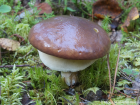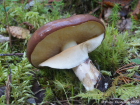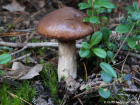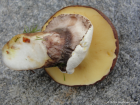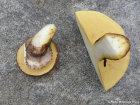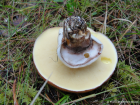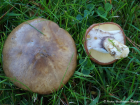Cap chestnut, rusty, olive-brown, or dark brown in colour. It has a distinctive conical shape, later flattening out. It is slimy to the touch, bare, smooth, and glossy even when dry, and the cuticle is easily peeled off. Flesh whitish with a yellow tinge, unchanging, moderate and soft, unchanging when cut. Pores tiny, circular, initially yellow but turn olive to dark yellow with maturity. Like the skin of the cap, they can be readily peeled away from the flesh. Tubes concolourous with pores, adnate. Stem pale straw-yellow at first but later darkening, more or less cylindrical but may bear a swollen base. A membranous partial veil initially links the stipe with the edge of the cap. When it ruptures, it forms a membranous, hanging ring with is at first whitish, darkening with age, vinaceous-brown below and large. Spore print ochraceous or buff coloured.
Microscopic Features: Spores are sub-fusiform, exhibiting a smooth surface, with dimensions of approximately 8-10.5μm in length and 3-3.5μm in width.
Suillus luteus on the Nature First Web site.
Suillus luteus on the MushroomExpert.Com Web site.
Many mushrooms are poisonous, and some can be lethally toxic. Distinguishing between edible and poisonous mushrooms can be very challenging. Therefore, we strongly advise against consuming wild mushrooms. This website does not contain any information about the edibility or toxicity of mushrooms.
Although efforts have been made to ensure accuracy on this website, the information may contain errors and omissions. Therefore, all content provided is for educational and informational purposes only and should not be relied upon or used as a basis for consuming any plants or mushrooms.
External links are provided for reference only. We do not endorse or take responsibility for the content, advice, or products found on these sites or in any advertisements shown on this website.
